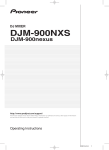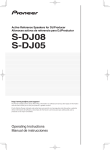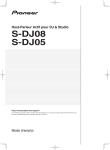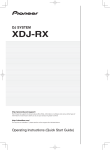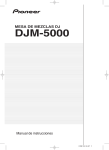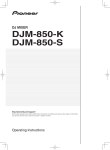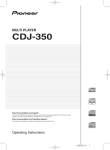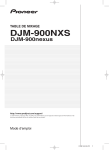Download Pioneer AVH-X3500BHS Stereo Receiver User Manual
Transcript
DJ MIXER DJM-250-K DJM-250-W http://www.prodjnet.com/support/ The Pioneer website shown above offers FAQs, information on software and various other types of information and services to allow you to use your product in greater comfort. Operating Instructions Thank you for buying this Pioneer product. Please read through these operating instructions so you will know how to operate your model properly. After you have finished reading the instructions, put them away in a safe place for future reference. In some countries or regions, the shape of the power plug and power outlet may sometimes differ from that shown in the explanatory drawings. However the method of connecting and operating the unit is the same. 1) 2) 3) 4) 5) 6) 7) Read these instructions. Keep these instructions. Heed all warnings. Follow all instructions. Do not use this apparatus near water. Clean only with dry cloth. Do not block any ventilation openings. Install in accordance with the manufacturer’s instructions. 8) Do not install near any heat sources such as radiators, heat registers, stoves, or other apparatus (including amplifiers) that produce heat. 9) Do not defeat the safety purpose of the polarized or grounding-type plug. A polarized plug has two blades with one wider than the other. A grounding type plug has two blades and a third grounding prong. The wide blade or the third prong are provided for your safety. If the provided plug does not fit into your outlet, consult an electrician for replacement of the obsolete outlet. 10) Protect the power cord from being walked on or pinched particularly at plugs, convenience receptacles, and the point where they exit from the apparatus. 11) Only use attachments/accessories specified by the manufacturer. 12) Use only with the cart, stand, tripod, bracket, or table specified by the manufacturer, or sold with the apparatus. When a cart is used, use caution when moving the cart/apparatus combination to avoid injury from tip-over. 13) Unplug this apparatus during lightning storms or when unused for long periods of time. 14) Refer all servicing to qualified service personnel. Servicing is required when the apparatus has been damaged in any way, such as power-supply cord or plug is damaged, liquid has been spilled or objects have fallen into the apparatus, the apparatus has been exposed to rain or moisture, does not operate normally, or has been dropped. D3-7-13-69_En NOTE: This equipment has been tested and found to comply with the limits for a Class B digital device, pursuant to Part 15 of the FCC Rules. These limits are designed to provide reasonable protection against harmful interference in a residential installation. This equipment generates, uses, and can radiate radio frequency energy and, if not installed and used in accordance with the instructions, may cause harmful interference to radio communications. However, there is no guarantee that interference will not occur in a particular installation. If this equipment does cause harmful interference to radio or television reception, which can be determined by turning the equipment off and on, the user is encouraged to try to correct the interference by one or more of the following measures: — Reorient or relocate the receiving antenna. — Increase the separation between the equipment and receiver. — Connect the equipment into an outlet on a circuit different from that to which the receiver is connected. — Consult the dealer or an experienced radio/TV technician for help. D8-10-1-2_A1_En This Class B digital apparatus complies with Canadian ICES-003. D8-10-1-3_A1_En Information to User Alterations or modifications carried out without appropriate authorization may invalidate the user’s right to operate the equipment. D8-10-2_A1_En IMPORTANT NOTICE THE MODEL NUMBER AND SERIAL NUMBER OF THIS EQUIPMENT ARE ON THE REAR OR BOTTOM. RECORD THESE NUMBERS ON PAGE 19 FOR FUTURE REFERENCE. D36-AP9-1_A1_En_PSV 2 En WARNING This equipment is not waterproof. To prevent a fire or shock hazard, do not place any container filled with liquid near this equipment (such as a vase or flower pot) or expose it to dripping, splashing, rain or moisture. D3-4-2-1-3_A1_En WARNING: Handling the cord on this product or cords associated with accessories sold with the product may expose you to chemicals listed on proposition 65 known to the State of California and other governmental entities to cause cancer and birth defect or other reproductive harm. D36-P5_B1_En WARNING Before plugging in for the first time, read the following section carefully. The voltage of the available power supply differs according to country or region. Be sure that the power supply voltage of the area where this unit will be used meets the required voltage (e.g., 230 V or 120 V) written on the side panel. This product is for general household purposes. Any failure due to use for other than household purposes (such as long-term use for business purposes in a restaurant or use in a car or ship) and which requires repair will be charged for even during the warranty period. K041_A1_En D3-4-2-1-4*_A1_En POWER-CORD CAUTION WARNING Operating environment temperature and humidity: +5 °C to +35 °C (+41 °F to +95 °F); less than 85 %RH (cooling vents not blocked) Do not install this unit in a poorly ventilated area, or in locations exposed to high humidity or direct sunlight (or strong artificial light) Handle the power cord by the plug. Do not pull out the plug by tugging the cord and never touch the power cord when your hands are wet as this could cause a short circuit or electric shock. Do not place the unit, a piece of furniture, etc., on the power cord, or pinch the cord. Never make a knot in the cord or tie it with other cords. The power cords should be routed such that they are not likely to be stepped on. A damaged power cord can cause a fire or give you an electrical shock. Check the power cord once in a while. When you find it damaged, ask your nearest PIONEER authorized service center or your dealer for a replacement. D3-4-2-1-7c*_A1_En S002*_A1_En To prevent a fire hazard, do not place any naked flame sources (such as a lighted candle) on the equipment. D3-4-2-1-7a_A1_En Operating Environment If the AC plug of this unit does not match the AC outlet you want to use, the plug must be removed and appropriate one fitted. Replacement and mounting of an AC plug on the power supply cord of this unit should be performed only by qualified service personnel. If connected to an AC outlet, the cut-off plug can cause severe electrical shock. Make sure it is properly disposed of after removal. The equipment should be disconnected by removing the mains plug from the wall socket when left unused for a long period of time (for example, when on vacation). D3-4-2-2-1a_A1_En CAUTION The ON/OFF switch on this unit will not completely shut off all power from the AC outlet. Since the power cord serves as the main disconnect device for the unit, you will need to unplug it from the AC outlet to shut down all power. Therefore, make sure the unit has been installed so that the power cord can be easily unplugged from the AC outlet in case of an accident. To avoid fire hazard, the power cord should also be unplugged from the AC outlet when left unused for a long period of time (for example, when on vacation). D3-4-2-2-2a*_A1_En The Safety of Your Ears is in Your Hands Get the most out of your equipment by playing it at a safe level – a level that lets the sound come through clearly without annoying blaring or distortion and, most importantly, without affecting your sensitive hearing. Sound can be deceiving. Over time, your hearing “comfort level” adapts to higher volumes of sound, so what sounds “normal” can actually be loud and harmful to your hearing. Guard against this by setting your equipment at a safe level BEFORE your hearing adapts. ESTABLISH A SAFE LEVEL: • Set your volume control at a low setting. • Slowly increase the sound until you can hear it comfortably and clearly, without distortion. • Once you have established a comfortable sound level, set the dial and leave it there. BE SURE TO OBSERVE THE FOLLOWING GUIDELINES: • Do not turn up the volume so high that you can’t hear what’s around you. • Use caution or temporarily discontinue use in potentially hazardous situations. • Do not use headphones while operating a motorized vehicle; the use of headphones may create a traffic hazard and is illegal in many areas. S001a_A1_En En 3 Contents How to read this manual The names of displays, menus, and buttons in this manual are enclosed in brackets. (e.g. [MASTER] channel, [ON/OFF], [File] menu) Before start Features........................................................................................................ 5 System setup example................................................................................ 5 What’s in the box......................................................................................... 5 Connections Names of Parts............................................................................................ 6 Connecting the input/output terminals..................................................... 7 About the AC adapter.................................................................................. 8 Operation Control panel.............................................................................................. 10 About the power switch of this unit......................................................... 10 Basic operations (mixer section)............................................................. 11 Using the filter function (filter section).................................................... 12 Selecting the crossfader’s curve characteristics (crossfader section)................................................................................... 12 Starting playback of a Pioneer DJ player using the fader (fader start section)................................................................................... 12 Monitoring the sound over headphones (headphones section)........... 13 Using a microphone or external device (MIC/AUX section).................. 13 Additional information Troubleshooting......................................................................................... 14 Block Diagram........................................................................................... 14 About trademarks and registered trademarks....................................... 15 Specifications............................................................................................ 15 4 En Before start Before start Features This unit is a DJ mixer that carries over the technology of the Pioneer DJM series, the world standard in club sound. It is a standard type unit equipped with the basic functions required for mixing, enabling full-fledged DJ play easily. SOUND COLOR FILTER MIC/AUX INPUT Each channel is equipped with a SOUND COLOR FILTER function by which filter effects can be achieved simply by turning a large control. This lets you arrange and mix tracks intuitively for DJ performances. This unit is equipped with three sets of AUX inputs for input of audio signals from external devices (computers, portable audio sets, TVs, synthesizers, etc.), as well as a microphone input. It can be used not only for DJ performances, but also as a pre-amp to appreciate music. 3-BAND EQUALIZER XLR OUTPUT This unit is equipped with a 3-band equalizer allowing the volume of the high, medium and low frequency ranges to be adjusted separately. Not only can the tone be adjusted to your tastes, the sound for a certain range can be turned completely off by turning the control all the way counterclockwise (isolator function). This unit is equipped with XLR balanced outputs featuring little loss of audio signal quality, enabling DJ performances with high sound quality. Also, it can be connected to powered speakers or other devices supporting XLR inputs without any changes to the terminals. System setup example A DJ system like the one shown on the diagram below can be achieved by combining this unit with a DJ player and peripheral equipment. For audio input For audio output INPUT INPUT 1 1 2 EQ 2 3 EQ POWER 4 Synthesizers, computers, portable audio devices, microphones, etc. Powered speakers, components, amplifiers, etc. S-DJ05, etc. MIC/AUX MIC OFF TRIM AUX 1 CD AUX 2 TIME MODE BACK REMAIN M S F TEMPO LOCK AUTO CUE A.CUE HI CH-1 DISC 0 9 HI MID BPM LOCK PLAYLIST EQ 12 9 12 LOW OUT RELOOP/EXIT ON 2 CHANNEL DJ MIXER DJM-250 TIME MODE BACK BEAT LOOP LOW VINYL MODE LOOP LOOP DRIVE TEMPO RANGE 12 9 12 OVER OVER +4 +4 +2 +2 0 0 -6 -6 -12 -12 -18 -18 dB dB 0 9 S F TEMPO A.CUE % 16 BPM SELECT PUSH INFO DISPLAY BROWSE USB STOP CH-2 M LOCK AUTO CUE MASTER LEVEL MASTER SELECT PUSH MP3/AAC WAV/AIFF OUT ADJUST OFF TRIM 9 HI LEVEL BPM UTILITY IN/CUE PHONO /LINE 9 BROWSE HOT LOOP CD REMAIN 16 SOURCE SELECT TRACK SEARCH PHONO /LINE AUX 3 % INFO DISPLAY USB STOP 3 POWER 4 DISC UTILITY MID SOURCE SELECT EQ BPM LOCK PLAYLIST MP3/AAC WAV/AIFF 9 LOW TRACK SEARCH IN/CUE OUT HOT LOOP OUT ADJUST RELOOP/EXIT BEAT LOOP VINYL MODE LOOP LEVEL 9 SEARCH LOOP DRIVE TEMPO RANGE SEARCH MASTER TEMPO MASTER TEMPO SOUND COLOR FILTER TEMPO TEMPO LPF HPF LPF HPF HEADPHONES FADER START CH-1 CH-1 CH-2 CH-2 MIXING 0 CUE 0 CUE MASTER CROSS FADER LEVEL CUE THRU CH-1 PLAY/PAUSE CH-2 PLAY/PAUSE 0 REV FWD REV MULTI PLAYER FWD MULTI PLAYER PHONES CDJ-350, etc. DJM-250 CDJ-350, etc. For checking the audio input/output Headphones HDJ-500, etc. What’s in the box ! AC adapter ! Power plug ! Operating instructions (this document) En 5 Connections Be sure to turn off the power and unplug the AC adapter from the power outlet before making or changing connections between devices. Wait until all connections between devices have been completed before connecting the AC adapter. Only use the AC adapter included with this unit. Refer to the operating instructions for the component to be connected. Names of Parts Rear panel, front panel 1 2 3 4 5 6 CH-2 ON PHONO / LINE OFF SIGNAL GND CD L LINE 7 3 4 CONTROL PHONO LINE 8 CH-1 PHONO / LINE 3 2 L MIC CONTROL PHONO 1 R L 9 AUX CD L R R DC IN 5 6 R R L 1GND 3 COLD 2 HOT MASTER 2 c b MASTER 1 a 1ON/OFF switch (page 10) Turns this unit’s power on and off. 2DC IN terminal Connect to a power outlet using the included AC adapter (with the power plug mounted). Wait until connection of all equipment is completed before connecting the AC adapter. Only use the included AC adapter. 3PHONO/LINE selector switch (page 7) Switches the function of the [PHONO/LINE] terminals. d aMASTER 1 terminals (page 7) Connect powered speakers, etc., here. ! Compatible with XLR connector type balanced outputs. bMASTER 2 terminals (page 7) Connect powered speakers, etc., here. ! Compatible with RCA pin-jack type unbalanced outputs. cCord hook Hook the AC adapters’ power cord here. dKensington security slot ! CAUTION When switching the [PHONO/LINE] selector switch, set [MASTER LEVEL] to [-∞]. Note that noise may be generated and sound output at a high volume. 4PHONO/LINE terminals (page 7) Connect a phono level output device (analog player (for MM cartridges), etc.) or a line level output device (DJ player, etc.) here. Switch the terminals’ function according to the connected device using the [PHONO/LINE] selector switch on this unit’s rear panel. 5CD terminals (page 7) Connect to a DJ player or other line level device. 6CONTROL terminal (page 7) Connect using a control cord (included with Pioneer DJ players). 7SIGNAL GND terminal (page 7) Connect an analog player’s ground wire here. This helps reduce noise when the analog player is connected. 8AUX terminals (page 7) Connect to the output terminals of external devices (computers, portable audio sets, TVs, synthesizers, etc.). 9MIC terminal (page 7) Connect to a microphone. 6 En e ePHONES jack (page 7) Connect headphones here. Connecting the input/output terminals Rear panel, front panel Audio input section Connections ! When creating a DVS (Digital Vinyl System) combining a computer, audio interface, etc., be careful in connecting the audio interface to this unit’s input terminals and in the settings of the input selector switches. Also refer to the operating instructions of the DJ software and audio interface. Example: CDJ-350 Audio cable R DJ player L L R AUDIO OUT Analog player Control cord 1 CONTROL USB To ground wire terminals To audio output terminals Ground wire Audio cable Microphone Microphone cable Rear panel CH-2 To power outlet ON PHONO / LINE OFF SIGNAL GND CD L CH-1 PHONO / LINE LL L LINE CONTROL PHONO R LINE R 3 L R 2 L CONTROL R R DC IN CD R PHONO To microphone AUX L L R RR MIC Portable audio device 1 L 1GND Audio cable 3 COLD 2 HOT AC adapter (included) R L MASTER 2 To audio output terminals MASTER 1 Audio output section Computer Powered speaker, component, amplifier, etc. Front panel INPUT Headphones INPUT 1 3 To audio output terminals 1 2 EQ POWER 4 Audio cable 2 EQ 3 POWER 4 synthesizer To audio input terminals Audio cable Headphones cord Audio cable To audio output terminals Audio cable 1 To use the fader start function, connect a control cord (page 12). The fader start function can only be used when connected to a Pioneer DJ player. Cord hook Loosen the cord hook’s screw and pinch the AC adapters’ power cord under the hook. Cord hook R DC IN R L MASTER 2 AC adapter’ s power cord ! Place the cord hook out of reach of children. If a child should swallow it, contact a physician immediately. En 7 About the AC adapter Safety instructions To ensure your personal safety and to maximize the full operating potential of your unit, read and follow these safety instructions. Read & Retain Instructions Read all operating and user information provided with this product. Cleaning Use a damp cloth to clean the exterior housing. Avoid using any fluids including liquid, aerosol or alcohol-based cleaning products. Water or Moisture Check that there are no irregularities with the AC adapter or power plug, then insert the power plug into the specified position of the AC adapter using the specified procedure until a click is heard. For details, see Mounting the power plug on page 9. If there are irregularities with the AC adapter or power plug, ask your nearest Pioneer authorized service center or your dealer to carry out repair work. ! Do not place the AC adapter cord around your neck. Doing so could result in suffocation. ! Do not use this unit with a coin, paper clip or other metal object stuck between the AC adapter and power plug. Doing so could cause a short circuit, leading to fire or electric shock. Avoid operating or locating this product near water or other sources of fluid. Accessories Do not place this product on an unstable cart, stand, or table. The product may fall and be seriously damaged. Ventilation Do not block or cover this product in use. This unit should not be placed in a built-in installation unless properly ventilated. Environment Avoid placing this product in a location with exposure to large quantities of dust, high temperatures, high humidity, or subject to excessive vibrations or shocks. Power Sources ! When mounting the AC adapter on a wall outlet, make sure there is no space between the AC adapter and the wall outlet. Faulty contact or a coin, paper clip or other metal object getting stuck in the space could cause a short circuit, leading to fire or electric shock. Coin, paper clip or other metal object Operate this product only from the recommended power sources. If you are unsure of the power source, consult an authorized Pioneer representative. Power-Cord Protection When unplugging the unit, pull on the plug – not on the cord. Do not handle the cord or plug with wet hands; doing so could cause an electric short or shock. Do not allow anything to pinch or rest on the power cord and do not place in a walkway. Power Turn OFF the system before installing this or any other hardware device. Overloading Avoid connecting too many devices to a single wall socket or power source as this can cause fires or short circuits. Object & Liquid Entry Never push inappropriate objects in to the device. Avoid spilling any liquids in to or on the outside of the drive. Top Side ! The power plug could come detached from the AC adapter and remain in the power outlet if someone trips on the AC adapter’s power cord or if something hits the AC adapter. If this happens, remove the power plug remaining in the outlet with dry hands, holding it as shown on the diagram below and without touching metal parts. Do not use any tools to remove it. Servicing Opening or removing the cover exposes you to possible electrical shock or other danger. Contact a Pioneer authorized service representative for repairing this product (refer to the enclosed Service & Support Card). Damage Requiring Service Unplug the unit and refer servicing to qualified service personnel in the following situations: ! When the power cord, plug, or chassis is damaged. ! If liquid has been spilled, or objects have fallen into the product. ! If the product has been exposed to rain or water. ! If the product does not operate normally when the operating instructions are followed. Adjust only those controls that are covered by the operating instructions. Improper adjustment of other controls may result in damage and can require extensive work by a qualified technician to restore the unit to its normal operation. ! When the product exhibits a distinct change in performance – this indicates a need for service. 8 En Do not touch. Mounting the power plug Connections Slide the power plug along the guide rails in the AC adapter unit as shown on the diagram below, then press in until a click is heard. Removing the power plug While pressing the [PUSH] button on the AC adapter unit, slide the power plug away from the adapter as shown on the diagram below to remove it. Once the power plug is mounted, there is no need to remove it. Power plug The power plug shown below is included with this product. En 9 Operation Mixer section Control panel MIC/AUX section 9 MIC/AUX MIC OFF TRIM AUX 1 AUX 2 2 AUX 3 LEVEL Two sets of audio signals can be adjusted separately for basic DJ mixing (page 11). Mixer section CD a b PHONO /LINE CD ON 9CD, PHONO/LINE input selector switch 2 CHANNEL DJ MIXER c 9 OFF TRIM PHONO /LINE 9 HI HI a b DJM-250 aTRIM control MASTER LEVEL MASTER 3 CH-1 0 9 HI d MID EQ 4 12 9 12 LOW LOW 12 OVER +4 +4 +2 +2 0 0 -6 -6 -12 -12 -18 -18 dB dB 0 9 d bEQ (HI, MID, LOW) control cMaster level indicator MID EQ dChannel level indicator 9 LOW LEVEL 9 12 1 CH-2 OVER eChannel fader 9 fCrossfader g SOUND COLOR FILTER h h LPF 5 Filter section HPF LPF Filter section HPF HEADPHONES FADER START CH-1 CH-1 CH-2 CH-2 i MIXING CUE Fader start section e 6 MASTER hSOUND COLOR FILTER control CROSS FADER LEVEL THRU CH-1 7 gSOUND COLOR FILTER indicator CH-2 f 0 j Crossfader section 8 Fader start section iCH-1, CH-2 buttons (fader start section) PHONES Headphones section Mixer section 1MASTER LEVEL control (page 11) MIC/AUX section This section handles the sound of microphones or external devices (computers, portable audio sets, TVs, synthesizers, etc.) (page 13). Crossfader section jTHRU, , (crossfader curve selector switch) About the power switch of this unit To turn the power on 2MIC, OFF, AUX 1, AUX 2, AUX 3 input selector switch 3LEVEL control (MIC/AUX section) 4HI, LOW controls Headphones section The sound being input to this unit can be checked over headphones (page 13). 5CH-1, CH-2 buttons (headphones section) 6MIXING control 7LEVEL control (headphones section) 8PHONES jack 10 En Set the [ON/OFF] switch on this unit’s rear panel to [ON]. This turns this unit’s power on (page 6). Basic operations (mixer section) 9 TRIM CD a b PHONO /LINE CD TRIM PHONO /LINE c 9 9 HI HI a b 9 MID d EQ 9 LOW 1 CH-2 OVER OVER +4 +4 +2 +2 0 0 -6 -6 -12 -12 -18 -18 dB dB 6 Turn the [MASTER LEVEL] control 1 clockwise. 9 d MID EQ 9 LOW LEVEL 9 Switch the channel whose sound is output from the speakers. — Left edge: The [CH-1] sound is output. — Center position: The sound of [CH-1] and [CH-2] is mixed and output. — Right edge: The [CH-2] sound is output. ! This operation is not necessary when the [THRU, , ] (crossfader curve selector) switch is set to [THRU]. 2 9 Sound is output from the speakers. The master level indicator c on the control panel lights. Adjust [MASTER LEVEL] so that the orange indicator lights at the point in the track where the volume is loudest (the climax, etc.). Be careful that the red indicator does not light, or the sound could be distorted. Operation MASTER CH-1 5 Move the crossfader f. SOUND COLOR FILTER LPF HPF LPF HPF Turn the [CH-1] 1 or [CH-2] 2 EQ (HI, MID, LOW) control b. e CH-1 Adjusting the sound quality CH-2 f Refer to Specifications on page 15 for the range of sound that can be adjusted by each control. ! The sound for that range can be turned completely off by turning the control all the way counterclockwise (isolator function). Mixing using the faders Outputting sound Check that this unit is properly connected to the DJ player, etc., before outputting sound. For instructions on connections, see Connecting the input/output terminals on page 7. Set the volume of the powered speakers connected to the [MASTER 1] and [MASTER 2] terminals to a suitable level. Note that sound will be output at a high volume if the volume is set too high. For instructions on monitoring the sound, see Monitoring the sound over headphones (headphones section) on page 13. To output the sound of channel 1 [CH-1] 1 Prepare the unit in advance so that the sound of [CH-1] 1 is being output from the speakers. For instructions on preparation, see Outputting sound on page 11. Mixing using the channel faders 1 Set [THRU, , ] (the crossfader curve selector switch) j to [THRU]. 2 Switch the [CH-2] 2 [CD, PHONO/LINE] input selector switch 9. 3 Turn the [CH-2] 2 [TRIM] control a clockwise. 4 Press the [CH-2] button 5 in the headphones section. To output the sound of channel 2 ([CH-2]) 2, perform the procedure below replacing [CH-1] with [CH-2]. The sound of [CH-2] is monitored from the headphones. 1 Switch the [CH-1] 1 [CD, PHONO/LINE] input selector switch 9. Adjust the monitor volume balance of the sound output from the [MASTER 1] or [MASTER 2] terminals (the [CH-1] sound) and the [CH-2] sound. Select the input source for [CH-1] from among the devices connected to this unit. —[CD]: Selects the DJ player connected to the [CD] terminals. —[PHONO/LINE]: Selects the device connected to the [PHONO/LINE] terminals. 2 Turn the [CH-1] 1 [TRIM] control a clockwise. Adjusts the audio level input to the [CH-1] terminal. The [CH-1] channel level indicator d lights when audio signals are being properly input to [CH-1]. Adjust the [TRIM] control so that the orange indicator lights where the track’s volume is highest (at the climax, etc.) Be careful that the red indicator does not light, or the sound could be distorted. 3 Move the [CH-1] 1 channel fader e away from you. The level of the sound output from the [CH-1] terminals is adjusted. 4 Switch [THRU, switch) j. , ] (the crossfader curve selector This switches the crossfader’s curve characteristics. For details, see Selecting the crossfader’s curve characteristics (crossfader section) on page 12. 5 Turn the [MIXING] control 6. 6 Operate the DJ player connected to the [CH-2] terminals. While checking the sound over the headphones, adjust the tempo of [CH-2] track to match the tempo of [CH-1] track. 7 While moving the [CH-2] 2 channel fader to the back, move the [CH-1] 1 channel fader to the front. While checking the sound output from the speakers, operate the channel faders to substitute the sound of [CH-1] with the sound of [CH-2]. Mixing is completed once only the [CH-2] sound is being output from the speakers. Mixing using the crossfader 1 Set [THRU, , ] (the crossfader curve selector switch) j to [ ] or [ ]. 2 Operate [CH-2] 2. Operate as described in steps 2 to 6 under Mixing using the channel faders on page 11. En 11 3 Move the crossfader f gradually towards the right. While checking the sound output from the speakers, operate the crossfader to substitute the sound of [CH-1] with the sound of [CH-2]. Mixing is completed once only the [CH-2] sound is being output from the speakers. Selecting the crossfader’s curve characteristics (crossfader section) CROSS FADER THRU j Using the filter function (filter section) g SOUND COLOR FILTER 1 2 LPF HPF LPF h HPF h Each channel is equipped with a SOUND COLOR FILTER function by which filter effects can be achieved simply by turning a large control. The treble or bass sound can be removed by turning the [SOUND COLOR FILTER] control h. Turn the [CH-1] 1 or [CH-2] 2 [SOUND COLOR FILTER] control h. The effect is applied to the sound and the indicator’s color changes. The effect type and indicator color differs according to the direction in which the [FILTER] control is turned, as shown on the table below. Direction of rotation Description of effect Indicator Left Applies the effect of the treble sound fading out. (LPF: low pass filter) Red (flashing) Center — Orange (lit) Right Applies the effect of the bass sound fading out. (HPF: high pass filter) Green (flashing) Mixing using the SOUND COLOR FILTER control Prepare the unit in advance so that the sound of [CH-1] 1 is being output from the speakers. For instructions on preparation, see Outputting sound on page 11. For instructions on monitoring the sound, see Monitoring the sound over headphones (headphones section) on page 13. 1 Operate the crossfader and [CH-2] 2. Operate as described in steps 2 to 6 under Mixing using the channel faders on page 11. Starting playback of a Pioneer DJ player using the fader (fader start section) FADER START CH-1 CH-2 i If you connect a Pioneer DJ player using a control cable (supplied with a DJ player), you can start playback of control other operations of the DJ player with the fader of this unit. The fader start function can only be used when connected to a Pioneer DJ player. Connect this unit and Pioneer DJ player beforehand. For instructions on connections, see Connecting the input/output terminals on page 7. To start playback using the channel faders 1 Set [THRU, , ] (the crossfader curve selector switch) j to [THRU]. 2 Press the [CH-1] or [CH-2] button i in the fader start section. Turn the fader start function on. 3 Move the channel fader e to the very front. 2 Turn the [CH-2] 2 [SOUND COLOR FILTER] control h fully clockwise. 4 Set the cue on the DJ player. 3 Move the [CH-2] 2 channel fader e away from you. 5 Move the channel fader e away from you. 4 While turning the [CH-1] 1 [SOUND COLOR FILTER] control h counterclockwise from the center, turn the [CH-2] 2 [SOUND COLOR FILTER] control h towards the center. While checking the sound output from the speakers, operate the [SOUND COLOR FILTER] controls h and replace the [CH-1] and [CH-2] sound. Move the [CH-1] 1 channel fader e towards the front. Mixing is completed once only the sound of [CH-2] is output from the speakers. 12 —[THRU]: Choose this when you do not want to use the crossfader. —[ ]: Set here for a curve that rises gradually. —[ ]: Set here for a curve that rises steeply. (When the crossfader moves away from either the left or right edge, the sound is immediately output from the opposite side.) En The DJ player pauses playback at the cue point. Playback starts on the DJ player. ! If you set the channel fader back to the original position, the player instantaneously returns to the cue point already set and pauses playback (back cue). To start playback using the crossfader 1 Set [THRU, , ] (the crossfader curve selector switch) j to [ ] or [ ]. Using a microphone or external device (MIC/AUX section) MIC/AUX MIC Turn the fader start function on. AUX 1 AUX 2 AUX 3 LEVEL 3 3 Move the crossfader f. 0 HI Move the crossfader to the opposite edge from the channel for which you want to use the fader start function. 4 4 Set the cue on the DJ player. The DJ player pauses playback at the cue point. 5 Move the crossfader f. Playback starts on the DJ player. ! If you set the crossfader back to the original position, the player instantaneously returns to the cue point already set and pauses playback (back cue). Monitoring the sound over headphones (headphones section) HEADPHONES CH-1 5 OFF 2 Operation 2 Press the [CH-1] or [CH-2] button i in the fader start section. 12 12 LOW 12 12 1 Switch the [MIC, OFF, AUX 1, AUX 2, AUX 3] input selector switch 2. —[MIC]: The microphone connected to the [MIC] terminal is selected. —[AUX1–3]: Selects the external device connected to the [AUX1–3] terminals. 2 Turn the [LEVEL] control 3 in the MIC/AUX section clockwise. The sound of the microphone or external device is output from the speakers. CH-2 MIXING 6 CUE Adjusting the sound quality MASTER LEVEL Turn the [HI] or [LOW] control 4 in the MIC/AUX section. 7 0 Refer to Specifications on page 15 for the range of sound that can be adjusted by each control. 8 PHONES 1 Connect headphones to the [PHONES] terminal. For instructions on connections, see Connecting the input/output terminals on page 7. 2 Press the [CH-1] or [CH-2] button 5 in the headphones section. Select the channel you want to monitor. —[CH-1]: The sound of [CH-1] is monitored. —[CH-2]: The sound of [CH-2] is monitored. ! This operation is not necessary to monitor the [MASTER 1] or [MASTER 2] (master channel) sound. 3 Turn the [MIXING] control 6. — When turned counterclockwise: The volume of [CH-1] and [CH-2] becomes relatively louder. — Center position: The volume of the [CH-1] and [CH-2] sound is the same level as the [MASTER 1] and [MASTER 2] sound. — When turned clockwise: The volume of [MASTER 1] and [MASTER 2] become relatively louder. 4 Turn the [LEVEL] control 7 in the headphones section clockwise. Sound is output from the headphones. ! When the [CH-1] or [CH-2] button in the headphones section is pressed again, monitoring is canceled. ![MASTER 1] and [MASTER 2] monitoring cannot be canceled. En 13 Additional information Troubleshooting ! Incorrect operation is often mistaken for trouble or malfunction. If you think that there is something wrong with this component, check the points below. Sometimes the trouble may lie in another component. Inspect the other components and electrical appliances being used. If the trouble cannot be rectified after checking the items below, ask your nearest Pioneer authorized service center or your dealer to carry out repair work. ! This unit may not operate properly due to static electricity or other external influences. In this case, proper operation may be restored by turning the power off, waiting 1 minute, then turning the power back on. Problem Check Remedy The power is not turned on. Is the included AC adapter properly connected? Connect the included AC adapter properly to the power outlet. (page 7) Properly attach the included AC adapter’s power cord to this unit’s cord hook. (Page 7) No sound or small sound. Is the [ON/OFF] switch for power supply set to [ON]? Set the [ON/OFF] switch for power supply to [ON]. (Page 10) Is the [CD, PHONO/LINE] input selector switch set to the proper position? Switch the [CD, PHONO/LINE] input selector switch to the channel’s input source. (Page 11) Is the [PHONO/LINE] selector switch on this unit’s rear panel set to the proper position? Switch the terminals’ function using the [PHONO/LINE] selector switch on this unit’s rear panel. (Page 6) Are the [TRIM], [channel fader], [crossfader] and [MASTER LEVEL] controls set to the proper positions? Set the [TRIM], [channel fader], [crossfader] and [MASTER LEVEL] controls to the proper positions. (Page 11) Are the connected powered speakers, etc., properly set? Properly set the external input selection, volume, etc., on the powered speakers, etc. Are the connection cables properly connected? Connect the connection cables properly. (page 7) Are the terminals and plugs dirty? Clean the terminals and plugs before making connections. Is [MASTER LEVEL] set at the proper position? Adjust the [MASTER LEVEL] control so that the master level indicator’s orange indicator lights at the peak level. (Page 11) Is [TRIM] set at the proper position? Adjust the [TRIM] control so that the channel level indicator’s orange indicator lights at the peak level. (Page 11) Can’t crossfade. Is the [THRU, , ] (crossfader curve selector) switch set to [THRU]? Set the [THRU, , ] (crossfader curve selector) switch to a position other than [THRU]. (Page 11) Can’t fader start a DJ player. Is the [CH-1] or [CH-2] button in the fader start section set to the off position? Set the [CH-1] or [CH-2] button in the fader start section to the on position. (page 12) Is the control cord properly connected? Connect this unit and DJ player with a control cord. (page 7) Are the audio cables properly connected? Connect this unit to the audio output terminal of a DJ player with an audio cable. (page 7) Have you connected an analog player with a builtin phono equalizer? If the analog player is equipped with a built-in phono equalizer, connect it to the [CD] terminals. (page 7) Distorted sound. Sound is distorted when an analog player is connected to this unit’s [PHONO/LINE] terminals. Or, lighting of the channel level indicator does not change even when the [TRIM] control is turned. If the analog player with built-in phono equalizer has a PHONO/LINE selector switch, switch it to PHONO. Is an audio interface for computers connected between the analog player and this unit? If the computer audio interface’s output is line level, connect it to the [CD] terminals. (page 7) If the analog player has a PHONO/LINE selector switch, switch it to PHONO. Block Diagram CD1 TRIM LINE1/ PHONO1 3Band EQ MASTER LEVEL METER FILTER CH 1 LEVEL METER HP CH 1 CH 1 FADER CD2 TRIM LINE2/ PHONO2 3Band EQ OFF AUX 1 CROSS FADER FILTER CH 2 LEVEL METER HP CH 2 MIC LEVEL CH 2 FADER AUX 2 HP MASTER AUX 3 HP CH 1 HP OUT HP MIX En HP VOL MASTER VOL HP MASTER 2Band EQ HP CH 2 14 MASTER 1 OUT MASTER 2 OUT About trademarks and registered trademarks ! Pioneer is a registered trademark of PIONEER CORPORATION. ! The names of companies and products mentioned herein are the trademarks of their respective owners. ! When playing music files you have acquired on this unit, we kindly ask you to respect copyrights. MASTER output terminal RCA pin jacks..................................................................................... 1 set BALANCED OUTPUT output terminal XLR connector................................................................................... 1 set PHONES output terminal Stereo phone jack (Ø 6.3 mm).......................................................... 1 set CONTROL terminal Mini phone jack (Ø 3.5 mm)............................................................ 2 sets ! The specifications and design of this product are subject to change without notice. Additional information Specifications AC adapter Power............................................................. AC 100 V to 240 V, 50 Hz/60 Hz Rated current...................................................................................... 800 mA Rated output.................................................................................. DC 5 V, 3 A General – Main Unit Main unit weight......................................................................3.1 kg (6.83 lb) Max. dimensions.................. 240 mm (W) × 107.7 mm (H) × 300.2 mm (D) (9.45 in. (W) × 4.24 in. (H) × 11.8 in. (D)) Tolerable operating temperature.......... +5 °C to +35 °C (+41 °F to +95 °F) Tolerable operating humidity....................... 5 % to 85 % (no condensation) Audio Section Sampling rate........................................................................................48 kHz A/D, D/A converter................................................................................24 bits Frequency characteristic CD/LINE/AUX/MIC.......................................................... 20 Hz to 20 kHz S/N ratio (rated output) CD..................................................................................................... 91 dB LINE.................................................................................................. 91 dB PHONO............................................................................................ 86 dB MIC................................................................................................... 80 dB Total harmonic distortion (CD — MASTER 1)...................................0.007 % Standard input level / Input impedance CD...................................................................................... –12 dBu/10 kW LINE................................................................................... –12 dBu/47 kW PHONO............................................................................. –48 dBu/47 kW MIC.................................................................................... –52 dBu/10 kW AUX 1................................................................................ –12 dBu/10 kW AUX 2, 3............................................................................ –12 dBu/10 kW Standard output level / Load impedance / Output impedance MASTER 1...............................................................+6 dBu/10 kW/330 W MASTER 2.................................................................+2 dBu/10 kW/1 kW PHONES......................................................................+2 dBu/32 W/33 W Rated output level / Load impedance MASTER 1........................................................................+22 dBu/10 kW MASTER 2........................................................................+18 dBu/10 kW Crosstalk (CD)........................................................................................ 74 dB Channel equalizer characteristic HI........................................................................... –∞ to + 9 dB (13 kHz) MID.......................................................................... –∞ to + 9 dB (1 kHz) LOW......................................................................... –∞ to +9 dB (70 Hz) MIC/AUX equalizer characteristics HI....................................................................–12 dB to +12 dB (10 kHz) LOW...............................................................–12 dB to +12 dB (100 Hz) Input/output terminals CD input terminal RCA pin jack..................................................................................... 2 sets PHONO/LINE input terminals RCA pin jack..................................................................................... 2 sets MIC input terminal Phone jack (Ø 6.3 mm)...................................................................... 1 set AUX input terminal RCA pin jack..................................................................................... 2 sets Mini phone jack (Ø 3.5 mm).............................................................. 1 set En 15 16 En Additional information 17 En 18 En Pioneer Electronics(USA) Inc. Limited Warranty PRODUCTS COVERED MODEL PREFIX DJ Compact Disc Player DJ DVD Player Digital Media Player DJ Mixer DJ Effector Video Switcher WARRANTY PERIOD Parts Labor CDJ, CMX .................................................................................... 1 YEAR DVJ .............................................................................................. 1 YEAR DMP ............................................................................................. 1 YEAR DJM ............................................................................................. 1 YEAR EFX .............................................................................................. 1 YEAR VSW ............................................................................................. 1 YEAR 1 YEAR 1 YEAR 1 YEAR 1 YEAR 1 YEAR 1 YEAR Additional information WARRANTY PERIOD For the period specified below from the date of original purchase (the warranty period), Pioneer Electronics(USA) Inc. (Pioneer) warrants that the products described below, if purchased directly from Pioneer or from an authorized Pioneer dealer or distributor in the United States and installed and operated according to operating instructions enclosed with the unit, will be repaired or replaced with a unit of comparable value, at the option of Pioneer, without charge to you for parts or labor for actual repair work if such products fail to function properly under normal use due to a manufacturing defect. Parts supplied under this warranty may be new or rebuilt at the option of Pioneer. This warranty covers the product during the warranty period whether in the possession of the original owner or any subsequent owner. WHAT’S NOT COVERED This warranty does not cover the A-B Cross Fader in the DJ Mixer (model prefix DJM). This warranty does not cover any appearance item, any damage to the product resulting from alterations, modifications not authorized in writing by Pioneer, accident, misuse or abuse, damage due to lightning or to power surges or personal injury due to excessive sound pressure levels. This warranty does not cover the cost of parts or labor which would be otherwise provided without charge under this warranty, obtained from any source other than a Pioneer Authorized Service Company or other designated location. This warranty does not cover defects or damage caused by the use of unauthorized parts or labor, or from improper maintenance. PRODUCTS WITH ALTERED, DEFACED OR REMOVED SERIAL NUMBERS SHALL VOID THIS WARRANTY. YOUR RIGHTS SOME STATES DO NOT ALLOW THE EXCLUSION OR LIMITATION OF INCIDENTAL OR CONSEQUENTIAL DAMAGES, SO THE FOLLOWING LIMITATIONS OR EXCLUSIONS MAY NOT APPLY TO YOU. THE ABOVE WARRANTIES ARE IN LIEU OF AND EXCLUDE ALL OTHER WARRANTIES, EXPRESSED OR IMPLIED, INCLUDING WITHOUT LIMITATION IMPLIED WARRANTIES OF MERCHANTABILITY AND FITNESS FOR ANY PARTICULAR PURPOSE. IN NO EVENT SHALL PIONEER BE LIABLE FOR INCIDENTAL OR CONSEQUENTIAL DAMAGES ARISING OUT OF LOSS OF USE OR CLAIMS ASSERTED ON THE BASIS OF TORT (INCLUDING NEGLIGENCE), CONTRACT, OR OTHERWISE. TO OBTAIN SERVICE Pioneer has appointed a number of Authorized Industrial Service Companies throughout the U.S.A. should your product ever require service. To receive warranty service you will need to present your sales receipt or, if rented, your rental contract showing place and date of original purchase transaction. Should it become necessary to ship the unit, you will need to package the product and send it, transportation prepaid, to an Authorized Service Company in the U.S.A. Carefully package the product using adequate padding material to prevent damage in transit. The original container is ideal for this purpose. Include in the package your name, address, telephone number where you can be reached during business hours, a copy of your sales receipt, and a detailed description of the problem. To find the name and address of the nearest Pioneer Authorized service location, to obtain warranty service or for additional information about this warranty. please call or write: PIONEER ELECTRONICS(USA) INC. CUSTOMER SUPPORT DIVISION P.O. BOX 1760 LONG BEACH, CALIFORNIA 90801-1760 1-800-872-4159 DO NOT RETURN ANY PRODUCT TO ABOVE ADDRESS. IT IS NOT A SERVICE LOCATION. TO ORDER REPLACEMENT PARTS CALL 800-228-7221 RECORD THE PLACE AND DATE OF PURCHASE FOR FUTURE REFERENCE Model No. Serial No. Purchase Date Purchased From KEEP THIS INFORMATION AND YOUR SALES RECEIPT IN A SAFE PLACE En 19 To register your product, find the nearest authorized service location, to purchase replacement parts, operating instructions, or accessories, please go to one of following URLs : Pour enregistrer votre produit, trouver le service après-vente agréé le plus proche et pour acheter des pièces de rechange, des modes d’emploi ou des accessoires, reportez-vous aux URL suivantes : In the USA/Aux Etats-Unis http://www.pioneerelectronics.com In Canada/Aux Canada http://www.pioneerelectronics.ca S018_B1_EnFr © 2011 PIONEER CORPORATION. All rights reserved. PIONEER CORPORATION 1-1, Shin-ogura, Saiwai-ku, Kawasaki-shi, Kanagawa 212-0031, Japan PIONEER ELECTRONICS (USA) INC. P.O. BOX 1540, Long Beach, California 90801-1540, U.S.A. TEL: (800) 421-1404 PIONEER ELECTRONICS OF CANADA, INC. 340 Ferrier Street, Unit 2, Markham, Ontario L3R 2Z5, Canada TEL: 1-877-283-5901, 905-479-4411 K002_PSV_CU Printed in China <DRB1581-A> <502-DM250A-3135>





















